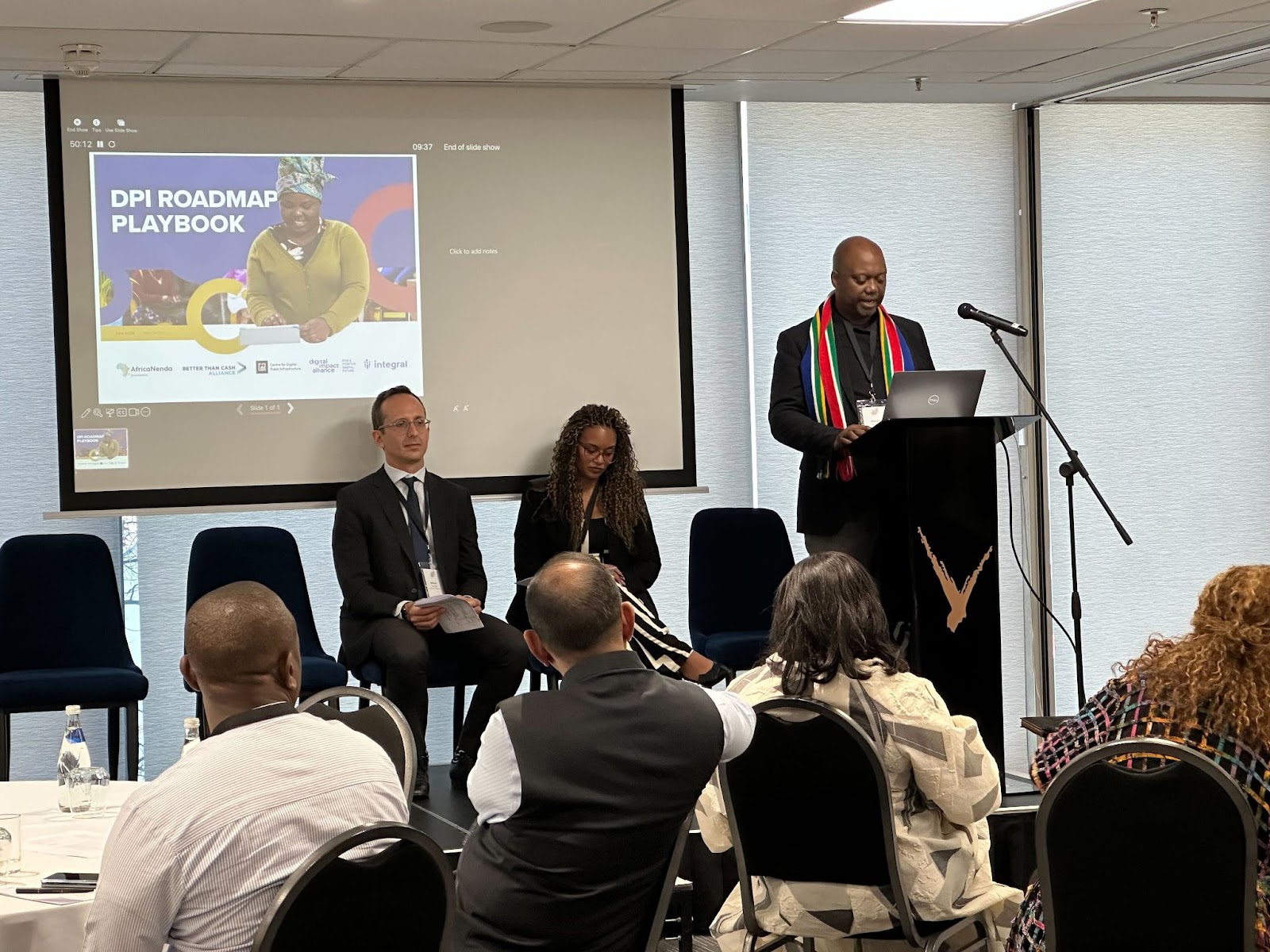Last month, I had the opportunity to attend a closed-door dialogue in Johannesburg hosted by the South African Presidency and partners, focused on one big question: How can Digital Public Infrastructure (DPI) be harnessed to drive prosperity across Africa?
With just 50 invited guests in the room, spanning national governments, regional blocs, funders, technologists, and civil society, the gathering was intentionally small, but the stakes were high. While South Africa is still shaping its domestic approach to DPI through its Digital Services Unit (DSU) and Digital Transformation Roadmap, it currently holds the G20 Presidency and will host the Global DPI Summit in 2025. This puts this important moment in Africa in a unique position to shape how DPI is developed, governed, and shared across the continent.
So, What is DPI and Why Does it Matter?
Digital Public Infrastructure refers to the basic set of digital tools that help people interact with their governments and access services. This includes things like having a digital ID to prove who you are, using digital payments to receive money or pay for services, and systems that allow different public departments to safely share data.
When built responsibly, DPI can make it easier for people to access public services, participate in the economy, and have their rights protected. But if it’s not built with care… if it’s not safe, inclusive, or respectful of people’s rights, it can also cause harm and leave people behind.
Above all, DPI must be designed to safeguard dignity, ensure data protection, and support equitable access. The principles of trust, transparency, and accountability cannot be optional. They are foundational.
DPI as a Driver of Growth, Inclusion and Trust
The consequences of not having adequate DPI are real and far-reaching. For example, one in three adults in Sub-Saharan Africa still doesn’t have a formal ID, according to the World Bank’s Global Findex. Without identification, people may be unable to open a bank account, register a SIM card, vote, or even access basic health or education services. This lack of documentation reinforces poverty and exclusion, especially for women, rural populations, and marginalised groups. DPI is one of the ways we can begin to change that.

A recurring message during the dialogue was that DPI isn’t about “tech for tech’s sake”. It’s about building infrastructure that enables inclusion. Sanjay Jain, Director of DPI at the Gates Foundation made a compelling point: the cost of building DPI isn’t as high as we might think, but the returns in inclusion, growth, and efficiency are massive.
We heard case studies from across the continent:
- Sierra Leone, during the Ebola crisis, built a rapid-response payment system to get funds into the hands of people who needed them most. It was a powerful example of how digital systems can help governments respond quickly and get support to people when it matters most.
- Ethiopia has rolled out a digital ID system built using Modular Open Source Identity Platform (MOSIP), an open-source platform that helps countries create secure, inclusive national ID programmes. Through this system, Ethiopians can now access 146 government services online, including healthcare, education, and administrative support, all in real-time.
- Nigeria has made significant progress in financial inclusion. By introducing digital systems that make it easier to verify someone’s identity remotely (also known as electronic Know Your Customer or eKYC), the country has reduced the gender gap in bank account ownership. More women can now open accounts and participate in the economy with greater ease and autonomy.
- Lesotho is moving fast with the right partnerships. Their approach is a reminder that DPI progress is possible with the right stakeholders aligned, even in smaller economies.
These examples are very promising. They are proof that DPI can work when it’s done intentionally, and with the most vulnerable citizen in mind.
The Role of Government as a Facilitator
One of the key themes from the discussion came from Mandla Ngcobo, Deputy Director General: eGovernment and Chief Information Officer in the Department of Public Service and Administration, who emphasised that government must act as a facilitator of DPI, not just a regulator or provider. This means creating enabling environments, adopting open-source technologies, and supporting ecosystems of public, private, and civil society actors.

This version aligns with OCL’s belief that collaboration and alignment across sectors are essential to deliver public value. As part of the MyMzansi initiative — South Africa’s digital transformation roadmap — we’ve been collaborating with National Treasury and Stats SA, along with stakeholders across the public and private sectors, to put Digital Public Infrastructure (DPI) principles into practice with a new ecosystem called MzansiXchange. The vision of MzansiXchange is to support secure, responsible, and rights-based data exchange in South Africa. It’s rooted in the belief that data should be treated as a public asset, and we can do that by ensuring it is protected, governed, and used to enable service delivery, not surveillance.
This work is particularly relevant as South Africa defines its approach to digital transformation. With MzansiXchange, we are:
- Testing new ways for different public departments and organisations to safely share data
- Looking at the rules and protections needed to manage that data responsibly
- Building examples that focus on the needs of marginalised communities
- Supporting the use of open, flexible technology that can work across systems
This is our contribution to the DPI conversation.
.jpeg)
The DPI Roadmap Playbook
One of the most exciting moments of the dialogue for me was the conversation about the DPI Roadmap Playbook - a guide that feels like a real turning point for how countries can approach digital transformation.
Developed by AfricaNenda, Digital Impact Alliance (DIAL), CDPI, Integral and the Better Than Cash Alliance, the Playbook is a practical, flexible toolkit designed to help countries shape DPI strategies that are truly fit or purpose, no matter where they are on their digital journey.
What makes it so compelling is how usable it is. It lays out clear steps to identify high-impact use cases, provides guidance for getting different arms of government aligned, and offers thoughtful frameworks for navigating the trade-offs that always come with system design. And it draws on real examples from countries like India, the UK, Kenya, Rwanda, Ghana, and of course, South Africa.
Collaboration is the Future
Entities like OCL have a key role to play in the DPI ecosystem. We’re civil society technologists and designers committed to bridging the gap between vision and implementation.
To realise the promise of DPI, we must work across the lines… Across countries, disciplines, and departments. That’s why these dialogues, and what comes next, matter so much.
The dialogue was full of momentum, and left us with important questions:
- How do we avoid surveillance creep while enabling data exchange?
- How can we ensure DPI reaches and empowers everyday residents, and not just institutions?
- How are citizens being meaningfully engaged in these transformations?
These are questions we’re asking ourselves everyday at OCL, as they’ll shape our work in the months and years ahead.
Email hello@opencitieslab.org to find out more about OCL’s DPI work and plans. We're on the lookout for key partnerships and collaborations to localize African-owned DPI that solves real African problems.


.jpg)
.jpg)
.jpg)





